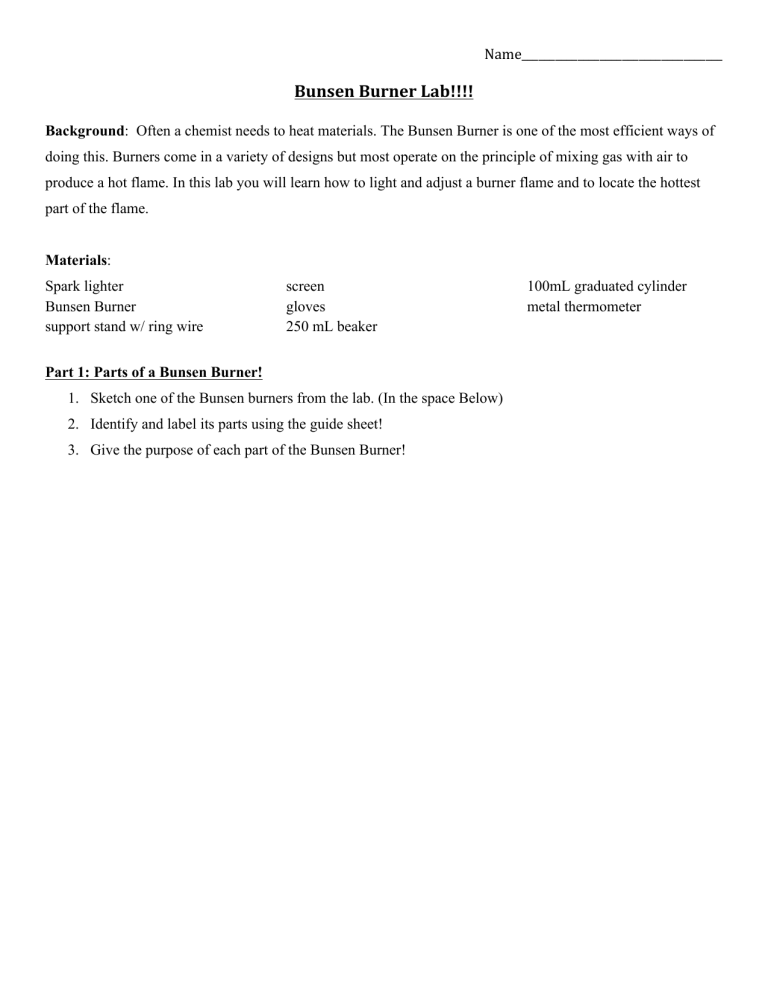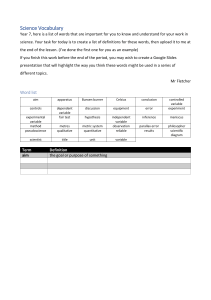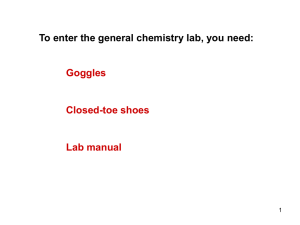
Name____________________________________
Bunsen Burner Lab!!!!
Background : Often a chemist needs to heat materials. The Bunsen Burner is one of the most efficient ways of doing this. Burners come in a variety of designs but most operate on the principle of mixing gas with air to produce a hot flame. In this lab you will learn how to light and adjust a burner flame and to locate the hottest part of the flame.
Materials :
Spark lighter
Bunsen Burner support stand w/ ring wire screen gloves
250 mL beaker
100mL graduated cylinder metal thermometer
Part 1: Parts of a Bunsen Burner!
1.
Sketch one of the Bunsen burners from the lab. (In the space Below)
2.
Identify and label its parts using the guide sheet!
3.
Give the purpose of each part of the Bunsen Burner!
Part 2: Setting Up a Bunsen Burner! WAIT FOR HELP FROM A BEFORE STEP 4!!!!!!!!!
Procedure:
1. Connect the hose to the table outlet. Clear the area of all flammable objects (including clothing & your hair!)
2. Turn the barrel so that the air intake openings are closed, and then open them three full turns.
3. Close the gas flow valve at the bottom of the burner, and then open it three full turns.
4. Put on your goggles, Call over a teacher to: open the gas valve on the table and light the burner .
5. Adjust the barrel so that the flame is pale blue with a dark blue inner cone.
Part 3: What is the Hottest Part of the Flame?
Procedure:
1. Set up the support stand, ring, and wire screen as shown in the photos (see below).
2. Position the ring clamp so that the beaker is at the position assigned to your group.
3. Put 100mL of water into the beaker and record the starting temperature of the water on your data sheet.
4. Heat the water and record temperature every 1 min.
5. Continue this until the water Boils (100 degrees Celsius). Write down the amount of time it took to boil!
6. Write data on board and Obtain data from all groups, make sure you have data from all heights.
Parts of the Flame!
2 cm 4 cm 6cm 8cm
Chemical Reaction occurring in the flame: C
3
H
8
+ 5O
2
-‐-‐-‐ 3CO
2
+ 4H
2
O
Data Table:
Fill in your data as well as the class data below. For Flame Position look at the diagram above and determine what part of the flame the bottom of the beaker is in. Fill in A,B,C or D in “Flame Position”
Height
2 cm
4 cm
6 cm
8 cm
10 cm
12 cm
Flame
Position
Starting
Temp
1 min 2 min 3 min 4 min 5 min 6 min 7 min 8 min
How long did it take your water to boil: ____________ What was the final Temperature:_________
Analysis/Conclusions
1.
Draw a Graph! a.
Using the data you collected create a graph of Temperature vs Time! b.
Make sure to include i.
Title ii.
Labeled Axis iii.
All four positions (A-‐D) graphed on the same graph paper iv.
All four best-‐fit lines for positions A-‐D are labeled or there is a Key.
2.
From the data that you have graphed determine what the hottest part of the flame is. Explain how you made this conclusion. Use your graph and data table to explain.
3.
What parts of the Bunsen burner allow air to be mixed in with the gas? Why do the gas and air need to be mixed (hint look at the reaction at the bottom of page 2)
4.
What sources of Error may have occurred during this lab? Find two examples and explain how your results may have been affected.
Parts of the Bunsen Burner Guide!!!
A. Barrel - Where gas and air are mixed
B. Collar - Adjust the air intake
C. Air intake openings - Air enters here
D. Gas Flow Valve - Regulates flow of gas (can also be controlled from table gas valve)
E. Gas intake tube – Gas enters burner from table source.
F. Base - Supports burner





